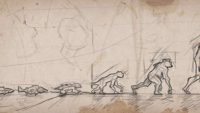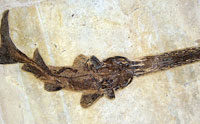Does astronomy disprove the Bible like many scoffers claim? Actually, history confirms that the Bible is always right when it touches on any subject—including astronomy. Learn how the Bible got astronomy right when it addresses the roundness of Earth, its suspension in space, the expansion of the heavens, and more! Listen: Astronomy: The Bible Got It Right! | The Institute for Creation Research
By Dr. Ross Anderson Life depends on all three of these elements (oxygen, carbon dioxide, and nitrogen) being in the gaseous form. …read more Source: AIG Daily
There’s a fundamental difference between operational science, which can be tested through repeatable experimentation, and historical science, which cannot. …read more Source: AIG Daily
A colour mutation that camouflages deer mice against a sandy background is a great example of natural selection. …read more Source: creation.com
Two recent articles in Nature Geoscience may provide important validations of the global Flood. Did researchers find evidence of the “fountains of the great deep” that started the deluge? More… …read more Source: icr.org
Evolutionists continue to wrestle with just how our nearest lunar neighbour was formed … and their explanations are unsatisfactory. …read more Source: creation.com
By Sarah Eshleman If you could look at a live scallop, you’d see its shell frilled with tentacles and a layer of flesh on the inside rim, edged with little dots—its eyes. …read more Source: AIG Daily
Data obtained by an instrument aboard the Cassini space probe have convinced planetary scientists that Saturn’s rings can be no more than a few hundred million years old.1 These new data confirmed some researchers’ previous suspicions. For instance, a previous ICR news article described how numerous planetary features within our solar system—including Saturn’s brilliant rings—look “young,” even to secular scientists.2 One of these features is the cleanness of Saturn’s rings. Secular scientists claim that the solar system is around 4.5 billion years old, so if Saturn’s rings were indeed that old, then they should have experienced billions of years’ [More]
Space probe Rosetta finds oxygen gas found in coma of comet 67P/Churyumov–;Gerasimenko …read more Source: creation.com
Millions of wooly mammoths once lived around the world, particularly in extremely cold places. These elephantine creatures present a major mystery for secular scientists. Why is that? How could wooly mammoths survive the frigid climate of an ice age? And where would they find a sufficient food supply? Read More: The Mystery of Wooly Mammoths | The Institute for Creation Research
The Polled Dorset breed of sheep did not evolve-its hornlessness is the result of a mutation. …read more Source: creation.com
Cycling engineers constantly seek to make their racing bikes faster and safer. They discovered a unique design in nature and adapted it to bike wheels. This design has an unexpected source. More… …read more Source: icr.org
By Dr. Ross Anderson This article recapitulates some of the many aspects of the element carbon that have clearly been shown to be perfectly matched for life. …read more Source: AIG Daily
By Ken Ham The more we learn about God’s creation, the more we should be moved to worship and stand in awe of him—because his creation is amazing! It seems no matter where researchers look, or what kind of research they do, they discover layer upon layer of complexity. And researchers just discovered another layer of complexity to our brains. Order your Body of Evidence DVD set today! Our brains really are incredible! And the more research that’s done, the more we realize what they are capable of. There’s no way our complex brains could come about by random chance [More]
By Dr. Nathaniel T. Jeanson Recently, a team of scientists from the United States, Canada, and Europe discovered a new species of unusual microbe. …read more Source: AIG Daily
By Troy Lacey Take a look at some of these astronomy/astrophysics-related news stories from the cosmic-evolutionary view and see how some have been paradigm changers. …read more Source: AIG Daily
Geologists reassessed the abundance of fossils in Earth’s uppermost rock layers this year, and they believe they found a remarkable sixth global extinction event. Their discovery has two significant implications. More… …read more Source: icr.org
We are all space travelers-and Spacecraft Earth helps us understand our place in God’s universe. …read more Source: creation.com
Some are concerned that global warming will cause the polar ice caps to melt, leading to an increase in global sea level. If such a rise in sea level occurred slowly, coastal peoples would have time to adjust to the change. But many are concerned that sea level could rise rapidly, leading to a humanitarian catastrophe. Although some scientists claim that satellite and tide-gauge data confirm a rapidly rising sea level, others are skeptical. In fact, two Australian scientists, Dr. Albert Parker and Dr. Clifford Ollier, have recently charged that Indian Ocean sea-level data for the last 140 years [More]
By Dr. Ross Anderson Each of the properties discussed in this article clearly shows that water is purposefully designed for making the earth habitable. …read more Source: AIG Daily
By Dr. Andrew Fabich With the correct biblical worldview in mind, Richard Lenski’s E. coli demonstrate an amazingly complex showcase for design by an all-knowing Creator. …read more Source: AIG Daily
By Avery Foley Real-life examples are increasingly showing the brain (particularly the infant brain) to be much more complex than this simplistic understanding. …read more Source: AIG Daily
The Institute for Creation Research has monitored the steady flow of fresh-looking fossils for over a decade. The year 2017 was impressive with its discoveries of biochemical variety that includes proteins, pigments, and even a pineal gland. Each such discovery presents a real challenge to the millions-of-years age assignments for these fossils, since best-case scenarios predict that biochemicals fizzle out in less than one million years. Read More: Best of 2017: Fleshy Fossils | The Institute for Creation Research
By Ken Ham The ability to study God’s creation—a rational universe we can make sense of—and do science is a great gift from our Creator. Science should move us to praise and glorify him. But, sadly, many worship the created creatures rather than their Creator. And many children are indoctrinated in government schools to think this way, instead of being encouraged to look to God’s Word, use that as the basis for science, and then do good science for God’s glory. Well, we have unique and exciting Learn more about the Creation Museum’s Explore days. Jennifer Rivera, the Creation Museum’s [More]
By Dr. Danny R. Faulkner One of the major proponents of using the big bang to prove God’s existence is the Christian philosopher William Lane Craig. …read more Source: AIG Daily
(Credit: NASA, H. Richey) It was heralded as decisive proof of the theory of evolution. But Harvard biologist and Nobel Prize laureate Jack Szostak now has retracted a major paper that claimed to explain one of the most important questions about the origin of human life. In 2016, Szostak published a paper claiming he had found…











































